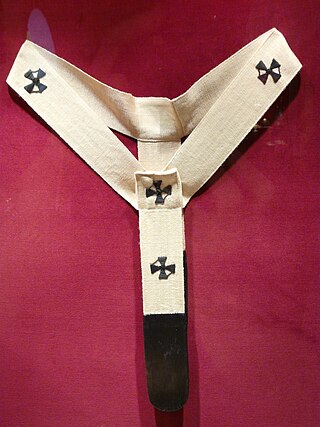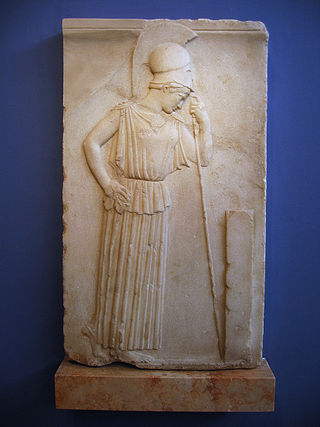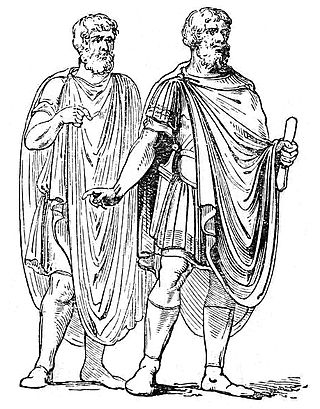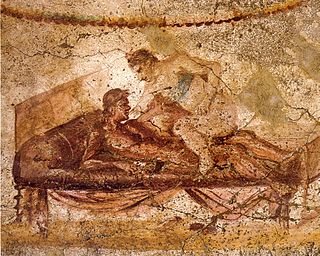
Tertullian was a prolific early Christian author from Carthage in the Roman province of Africa. He was the first Christian author to produce an extensive corpus of Latin Christian literature and was an early Christian apologist and a polemicist against heresy, including contemporary Christian Gnosticism. Tertullian has been called "the father of Latin Christianity", as well as "the founder of Western theology".

The pallium is an ecclesiastical vestment in the Catholic Church, originally peculiar to the Pope, but for many centuries bestowed by the Holy See upon metropolitans and primates as a symbol of their conferred jurisdictional authorities, and still remains a papal emblem.

A cloak is a type of loose garment worn over clothing, mostly but not always as outerwear for outdoor wear, serving the same purpose as an overcoat, protecting the wearer from the weather. It may form part of a uniform. People in many different societies may wear cloaks. Over time cloak designs have changed to match fashion and available textiles.

The toga, a distinctive garment of ancient Rome, was a roughly semicircular cloth, between 12 and 20 feet in length, draped over the shoulders and around the body. It was usually woven from white wool, and was worn over a tunic. In Roman historical tradition, it is said to have been the favored dress of Romulus, Rome's founder; it was also thought to have originally been worn by both sexes, and by the citizen-military. As Roman women gradually adopted the stola, the toga was recognized as formal wear for male Roman citizens. Women found guilty of adultery and women engaged in prostitution might have provided the main exceptions to this rule.

The stola was the traditional garment of Roman women, corresponding to the toga that was worn by men. It was also called vestis longa in Latin literary sources, pointing to its length.

A peplos is a body-length garment established as typical attire for women in ancient Greece by c. 500 BC, during the late Archaic and Classical period. It was a long, rectangular cloth with the top edge folded down about halfway, so that what was the top of the rectangle was now draped below the waist, and the bottom of the rectangle was at the ankle. One side of the peplos could be left open, or pinned or sewn together. In Latin and in a Roman context, it could be called a palla.

A tunic is a garment for the body, usually simple in style, reaching from the shoulders to a length somewhere between the hips and the knees. The name derives from the Latin tunica, the basic garment worn by both men and women in Ancient Rome, which in turn was based on earlier Greek garments that covered wearers' waists.

Byzantine dress changed considerably over the thousand years of the Empire, but was essentially conservative. Popularly, Byzantine dress remained attached to its classical Greek roots with most changes and different styles being evidenced in the upper strata of Byzantine society always with a touch of the Hellenic environment. The Byzantines liked colour and pattern, and made and exported very richly patterned cloth, especially Byzantine silk, woven and embroidered for the upper classes, and resist-dyed and printed for the lower. A different border or trimming round the edges was very common, and many single stripes down the body or around the upper arm are seen, often denoting class or rank. Taste for the middle and upper classes followed the latest fashions at the Imperial Court.

A chiton is a form of tunic that fastens at the shoulder, worn by men and women of ancient Greece and Rome. There are two forms of chiton: the Doric and the later Ionic. According to Herodotus, popular legend was that Athenian women began to wear the chiton as opposed to the peplos after several women stabbed a messenger to death with the bronze pins characteristic of the peplos.

A himation was a type of clothing, a mantle or wrap worn by ancient Greek men and women from the Archaic period through the Hellenistic period. It was usually worn over a chiton and/or peplos, but was made of heavier drape and played the role of a cloak or shawl. When the himation was used alone, without a chiton, it served both as a chiton and as a cloak. The himation was markedly less voluminous than the Roman toga. Many vase paintings depict women wearing a himation as a veil covering their faces.

An abolla was a cloak-like garment worn by ancient Greeks and Romans. Nonius Marcellus quotes a passage of Varro to show that it was a garment worn by soldiers, and thus opposed to the toga. Roman women also wore a version of the abolla by at least the Imperial Period.

The palla was an elegant cloak or mantle that was wrapped around the body. It was worn outside the house by (affluent) Roman women. It was a luxurious version of the Roman women's pallium. The palla was a traditional ancient Roman mantle worn by women, fastened by brooches. The shape was rectangular instead of semi-circular, as with the traditional toga. The garment dates to the 3rd century BC, but the type of dress must be much older. In Latin literature, the term palla is used ambiguously. It can denote not only a cloak, but also a foot-long sleeveless dress with straps worn directly on the skin. The second is a common dress form in the entire Mediterranean world. In a Greek cultural context, this is called peplos. In a Roman cultural context, if worn by a Roman matron, it also takes the name stola.

Clothing in ancient Rome generally comprised a short-sleeved or sleeveless, knee-length tunic for men and boys, and a longer, usually sleeved tunic for women and girls. On formal occasions, adult male citizens could wear a woolen toga, draped over their tunic, and married citizen women wore a woolen mantle, known as a palla, over a stola, a simple, long-sleeved, voluminous garment that modestly hung to cover the feet. Clothing, footwear and accoutrements identified gender, status, rank and social class. This was especially apparent in the distinctive, privileged official dress of magistrates, priesthoods and the military.

The preservation of fabric fibers and leathers allows for insights into the attire of ancient societies. The clothing used in the ancient world reflects the technologies that these peoples mastered. In many cultures, clothing indicated the social status of various members of society.

The paenula or casula was a cloak worn by the Romans, akin to the poncho. The paenula was usually closed in the front but, occasionally, could be left with an open front; it could be also made with shorter sides to increase mobility for the arms. This was originally worn only by slaves, soldiers and people of low degree; in the 3rd century, however, it was adopted by fashionable people as a convenient riding or travelling cloak, and finally, by the sumptuary law of 382 it was prescribed as the proper everyday dress of senators, instead of the military chlamys. Thereafter, the toga was reserved for state occasions.

Prostitution in ancient Rome was legal and licensed. Men of any social status were free to engage prostitutes of either sex without incurring moral disapproval, as long as they demonstrated self-control and moderation in the frequency and enjoyment of sex. Brothels were part of the culture of ancient Rome, as popular places of entertainment for Roman men.

Clothing in ancient Greece refers to clothing starting from the Aegean bronze age to the Hellenistic period. Clothing in ancient Greece included a wide variety of styles but primarily consisted of the chiton, peplos, himation, and chlamys. Ancient Greek civilians typically wore two pieces of clothing draped about the body: an undergarment and a cloak. The people of ancient Greece had many factors that determined what they wore and when they wore it.

In the context of clothing, a wrap can refer to a shawl or stole or other fabric wrapped about the upper body, or a simple skirt-type garment made by wrapping a piece of material round the lower body. Many people of all genders throughout the world wear wraps in everyday life, although in the West they are largely worn by women. They are sometimes sewn at the edges to form a tube which keeps the required size. A wrap may be secured by a corner being tucked beneath the wrapped material, by making a knot, or using ties, buttons or velcro.

The clothing of the people in biblical times was made from wool, linen, animal skins, and perhaps silk. Most events in the Hebrew Bible and New Testament take place in ancient Israel, and thus most biblical clothing is ancient Hebrew clothing. They wore underwear and cloth skirts.
A kandys, plural kandyes, also called candys, kantuš or Median robe, is a type of three-quarter-length Persian coat. It originally described a leather cloak with sleeves worn by men, but evolved into a garment worn by Athenian women. The kandys is sometimes compared to the much later 17th-19th century military pelisse as worn by Hussars, in the sense that it was a sleeved jacket or coat worn cloak-style.


















